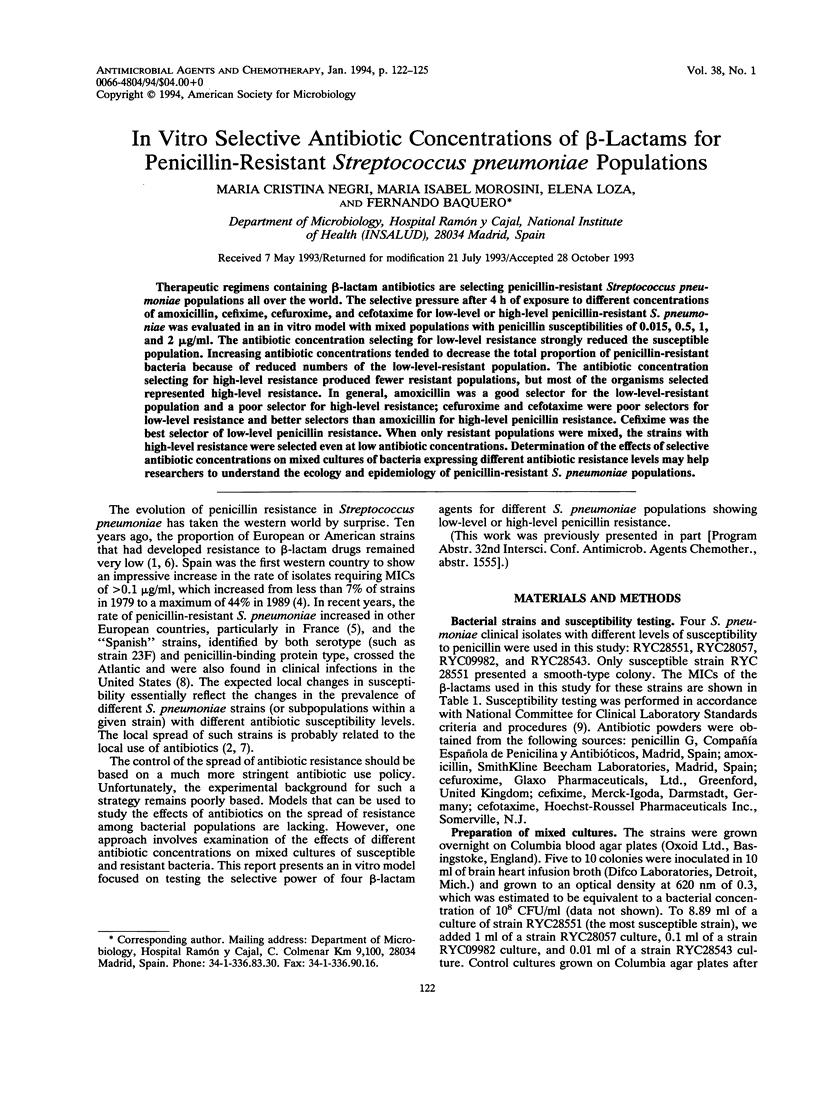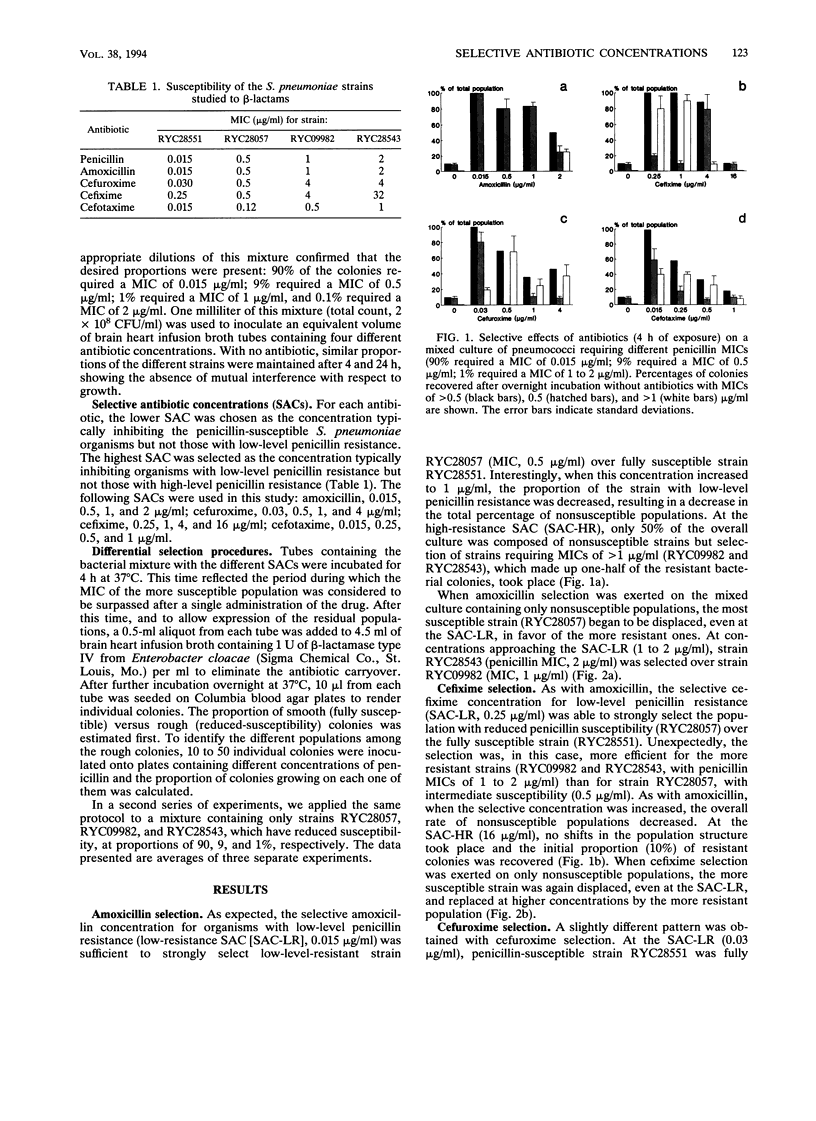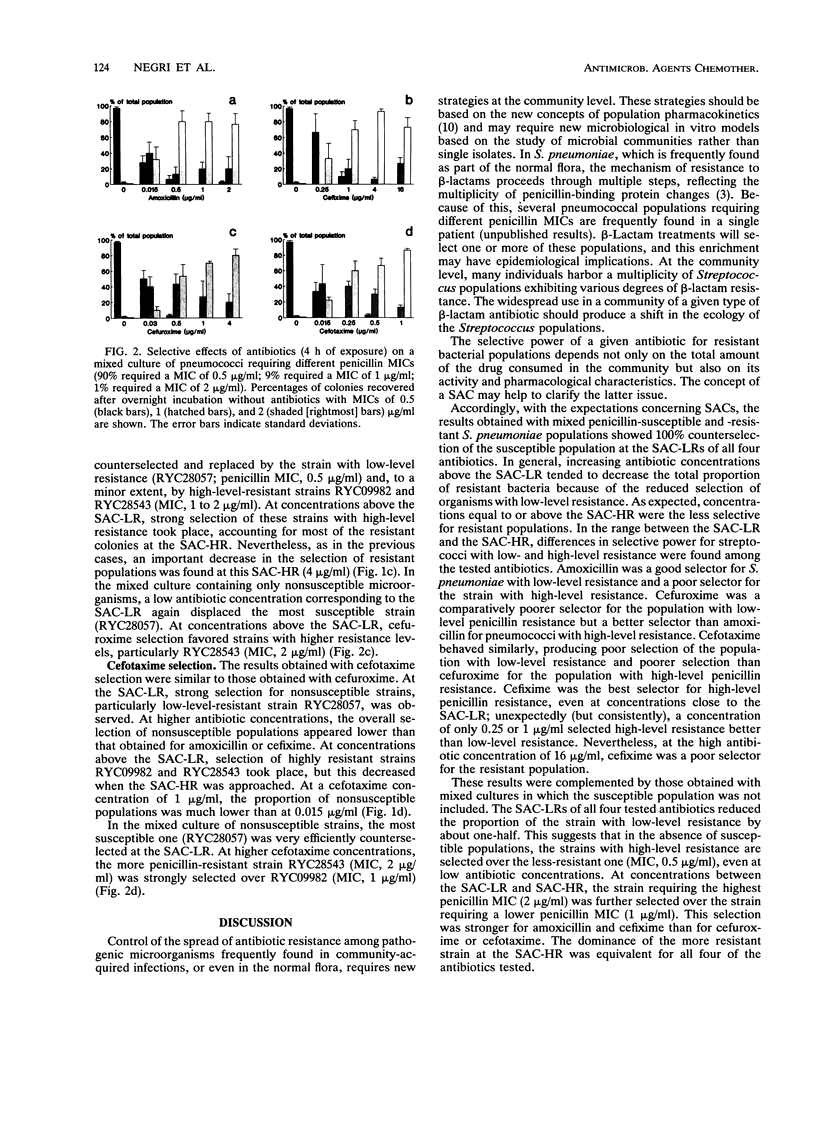Abstract
Therapeutic regimens containing beta-lactam antibiotics are selecting penicillin-resistant Streptococcus pneumoniae populations all over the world. The selective pressure after 4 h of exposure to different concentrations of amoxicillin, cefixime, cefuroxime, and cefotaxime for low-level or high-level penicillin-resistant S. pneumoniae was evaluated in an in vitro model with mixed populations with penicillin susceptibilities of 0.015, 0.5, 1, and 2 micrograms/ml. The antibiotic concentration selecting for low-level resistance strongly reduced the susceptible population. Increasing antibiotic concentrations tended to decrease the total proportion of penicillin-resistant bacteria because of reduced numbers of the low-level-resistant population. The antibiotic concentration selecting for high-level resistance produced fewer resistant populations, but most of the organisms selected represented high-level resistance. In general, amoxicillin was a good selector for the low-level-resistant population and a poor selector for high-level resistance; cefuroxime and cefotaxime were poor selectors for low-level resistance and better selectors than amoxicillin for high-level penicillin resistance. Cefixime was the best selector of low-level penicillin resistance. When only resistant populations were mixed, the strains with high-level resistance were selected even at low antibiotic concentrations. Determination of the effects of selective antibiotic concentrations on mixed cultures of bacteria expressing different antibiotic resistance levels may help researchers to understand the ecology and epidemiology of penicillin-resistant S. pneumoniae populations.
Full text
PDF



Selected References
These references are in PubMed. This may not be the complete list of references from this article.
- Appelbaum P. C. Antimicrobial resistance in Streptococcus pneumoniae: an overview. Clin Infect Dis. 1992 Jul;15(1):77–83. doi: 10.1093/clinids/15.1.77. [DOI] [PubMed] [Google Scholar]
- Baquero F., Martínez-Beltrán J., Loza E. A review of antibiotic resistance patterns of Streptococcus pneumoniae in Europe. J Antimicrob Chemother. 1991 Dec;28 (Suppl 100):31–38. doi: 10.1093/jac/28.suppl_c.31. [DOI] [PubMed] [Google Scholar]
- Coffey T. J., Dowson C. G., Daniels M., Zhou J., Martin C., Spratt B. G., Musser J. M. Horizontal transfer of multiple penicillin-binding protein genes, and capsular biosynthetic genes, in natural populations of Streptococcus pneumoniae. Mol Microbiol. 1991 Sep;5(9):2255–2260. doi: 10.1111/j.1365-2958.1991.tb02155.x. [DOI] [PubMed] [Google Scholar]
- Fenoll A., Martín Bourgon C., Muñz R., Vicioso D., Casal J. Serotype distribution and antimicrobial resistance of Streptococcus pneumoniae isolates causing systemic infections in Spain, 1979-1989. Rev Infect Dis. 1991 Jan-Feb;13(1):56–60. doi: 10.1093/clinids/13.1.56. [DOI] [PubMed] [Google Scholar]
- Klugman K. P. Pneumococcal resistance to antibiotics. Clin Microbiol Rev. 1990 Apr;3(2):171–196. doi: 10.1128/cmr.3.2.171. [DOI] [PMC free article] [PubMed] [Google Scholar]
- Marton A. Pneumococcal antimicrobial resistance: the problem in Hungary. Clin Infect Dis. 1992 Jul;15(1):106–111. doi: 10.1093/clinids/15.1.106. [DOI] [PubMed] [Google Scholar]
- Muñoz R., Coffey T. J., Daniels M., Dowson C. G., Laible G., Casal J., Hakenbeck R., Jacobs M., Musser J. M., Spratt B. G. Intercontinental spread of a multiresistant clone of serotype 23F Streptococcus pneumoniae. J Infect Dis. 1991 Aug;164(2):302–306. doi: 10.1093/infdis/164.2.302. [DOI] [PubMed] [Google Scholar]
- Sheiner L. B., Ludden T. M. Population pharmacokinetics/dynamics. Annu Rev Pharmacol Toxicol. 1992;32:185–209. doi: 10.1146/annurev.pa.32.040192.001153. [DOI] [PubMed] [Google Scholar]


